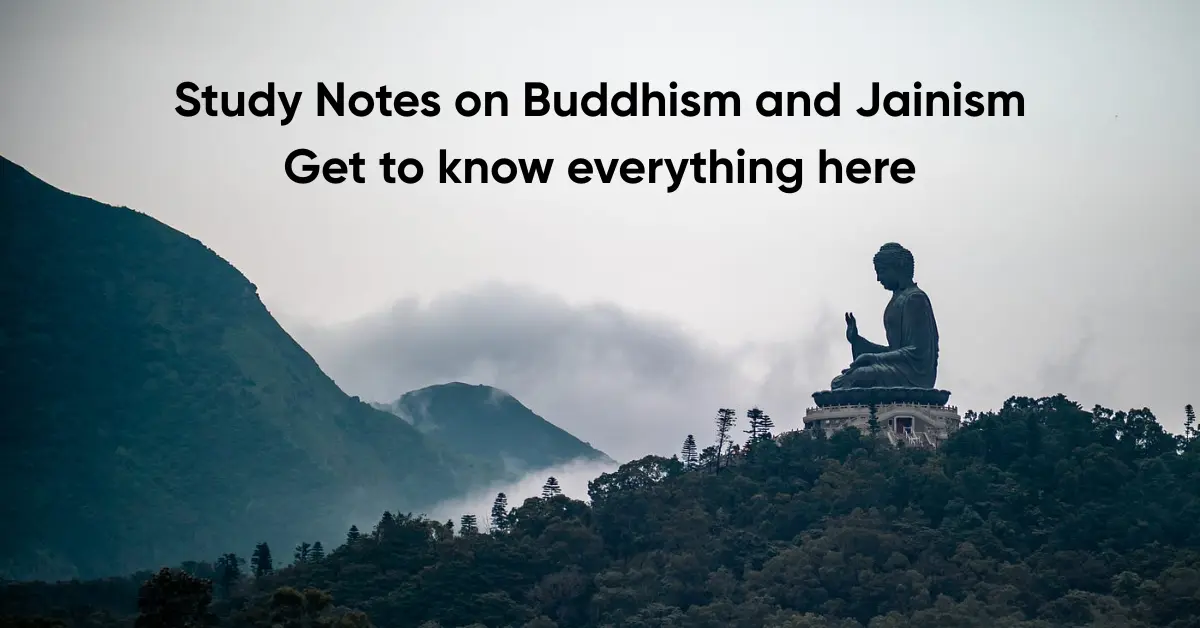General Awareness is one of the most important sections in competitive exams like SSC, Banking, and other government jobs. To score well, it’s important to stay updated with both current affairs and static GK. One such key topic is Buddhism and Jainism, which is commonly asked in these exams. If you are preparing for SSC CGL, CHSL, Banking, or similar exams, make sure to revise this topic carefully. In this blog, we’ll provide you with clear and concise notes on Buddhism and Jainism to help you prepare better and boost your score in the General Awareness section.
Study Notes on Buddhism and Jainism
Buddhism and Jainism are two major religious movements that emerged in India during the 6th century BC as a response to social inequality and rigid caste practices. Understanding their teachings, founders, and differences is important for competitive exams like SSC, Banking, and other government jobs.
Buddhism and Jainism – Their Emergence
By 6th Century BC, the caste system became highly complicated and the lower caste people faced all socio-economic problems while high caste people led a safe and dignified life. These lower caste people were ready to move to some other religion where there were no such discriminations. An it was during this time new religions like Jainism, Buddhism and many other religions emerged. They acted as an alternative to the present caste system and many other people started following these new religions where they could live a life with dignity.
Buddhism
Buddhism was founded as a reform movement against ritualism and caste-based discrimination. It focuses on self-discipline, non-violence, and the path to enlightenment.
- Founder: Siddhartha Gautama (Buddha), born in 563 BC at Lumbini near Kapilavastu
- Left palace at the age of 29 in search of truth
- Attained enlightenment at the age of 35 under a tree at Bodh Gaya (then Uruvela)
- Gave his first sermon at Sarnath, known as Dharmachakrapravartana
- Taught Four Noble Truths:
- Life is full of suffering
- Desire is the root cause of suffering
- Ending desire ends suffering
- Desire can be ended by following the Eightfold Path
- Eightfold Path: Right understanding, thought, speech, action, livelihood, effort, mindfulness, and concentration
- Opposed the caste (varna) system
- Died in 483 BC at Kushinagar (Malla Mahajanapada)
- Buddhist Councils:
- 1st Council (483 BC) – Rajgir under Ajatashatru; compilation of Sutta Pitaka and Vinaya Pitaka
- 2nd Council (383 BC) – Vaishali under Kalashoka
- 3rd Council (250 BC) – Patliputra under Ashoka; Abhidhamma Pitaka compiled
- 4th Council (1st Century AD) – Kundalavana (Kashmir) under Kanishka; split into Hinayana and Mahayana
- Major Sects:
- Hinayana: Original teachings, no idol worship, texts in Pali
- Mahayana: Idol worship started, texts in Sanskrit
- Vajrayana: Believed enlightenment could be achieved through rituals and mantras
Buddhist Councils
The Buddhist Councils were held to preserve and standardize the teachings of Buddha. Each council played a key role in shaping Buddhist texts and sects.
| Council | Year | Location | Patron King | Presided By | Outcomes |
| 1st | 483 BC | Rajgir | Ajatashatru | Mahakassapa | Compilation of Sutta Pitaka and Vinaya Pitaka |
| 2nd | 383 BC | Vaishali | Kalashoka | Sabakami | Addressed monastic disciplinary issues |
| 3rd | 250 BC | Pataliputra | Ashoka | Moggaliputta Tissa | Composition of Abhidhamma Pitaka; spread of Buddhism |
| 4th | 1st Century AD | Kundalvana (Kashmir) | Kanishka | Vasumitra | Division into Hinayana and Mahayana sects |
Sects of Buddhism
Buddhism gradually branched into different schools based on beliefs and practices. The three major sects are:
- Hinayana
- Focuses on the original teachings of Gautam Buddha.
- Believes in personal salvation through self-discipline and meditation.
- Does not support idol worship.
- Scriptures were written in Pali.
- Mahayana
- Emphasizes idol worship and the concept of Bodhisattvas.
- Believes in collective salvation and compassion toward others.
- Scriptures were written in Sanskrit.
- Vajrayana
- Developed later in Tibet and Himalayan regions.
- Believes that rituals, chants, and mystical practices (often referred to as ‘tantras’) help in attaining enlightenment.
- Associated with esoteric methods, sometimes misunderstood as black magic.
Jainism – Study Notes
Jainism is one of the oldest religions of India, founded as a reform movement against Vedic rituals and caste-based hierarchy. It emphasizes non-violence (Ahimsa), truth, discipline, and a simple way of living. The religion evolved during the 6th century BCE, around the same time as Buddhism, offering an alternative path to salvation for those dissatisfied with orthodox practices.
Points on Jainism
- Tirthankaras: Jainism recognizes 24 Tirthankaras, or spiritual leaders.
- Rishabha was the first Tirthankara.
- Vardhaman Mahavira, the 24th and last Tirthankara, played a major role in spreading Jain philosophy.
- About Mahavira:
- Born in 540 BCE at Kundagrama, near Vaishali (Bihar).
- Renounced worldly life at age 30.
- Attained Keval Jnana (absolute knowledge) at age 42 under a sal tree.
- Preached for over 30 years and passed away at Pavapuri in 468 BCE.
- Three Jewels (Ratnatraya): The path to liberation involves:
- Right Faith (Samyak Darshan)
- Right Knowledge (Samyak Jnana)
- Right Conduct (Samyak Charitra)
- Five Great Vows (Mahavratas):
These are practiced strictly by monks and partially by laypersons:- Ahimsa – Non-violence
- Satya – Truth
- Asteya – Non-stealing
- Aparigraha – Non-possession
- Brahmacharya – Celibacy
- Division into Sects:
Jainism later split into two major sects:- Shwetambaras (white-clad monks): Believe women can attain salvation.
- Digambaras (sky-clad monks): Do not accept women into the monkhood and believe in strict asceticism.
Jain Council
Two main Jain Councils were held to preserve and codify the teachings of Mahavira:
- First Council
- Held in 3rd century BCE at Pataliputra.
- Led by Sthulabhadra.
- Resulted in compilation of 12 Angas (Jain scriptures).
- Second Council
- Held in 5th century CE at Valabhi (Gujarat).
- Presided over by Devardhigani Kshamasramana.
- Final redaction and preservation of Jain texts were done here in written form.
Types of Knowledge in Jainism
Jainism classifies knowledge into five distinct types, each representing a higher level of spiritual awareness:
- Mati Jnana – Direct knowledge through the senses and mind
- Shruta Jnana – Knowledge acquired through scriptures
- Avadhi Jnana – Clairvoyant knowledge (limited but extraordinary perception)
- Manahparyaya Jnana – Telepathic knowledge (knowing others’ thoughts)
- Keval Jnana – Omniscience (perfect and infinite knowledge)
Buddhism and Jainism -FAQs
Ans. Gautama Buddha (Siddhartha Gautama) founded Buddhism in the 6th century BCE.
Ans. The three major sects are Hinayana, Mahayana, and Vajrayana.
Ans. Keval Jnana is omniscient knowledge, the highest and perfect form of spiritual knowledge.
Ans. The Fourth Buddhist Council, held under Kanishka in Kashmir, led to this division.
Ans.
Ahimsa (Non-violence)
Satya (Truth)
Asteya (Non-stealing)
Brahmacharya (Celibacy)
Aparigraha (Non-possession)
- IBPS RRB PO Exam Analysis 2025, 22nd November All Shifts
- Sarkari Result 2025, Latest सरकारी नौकरी Updates & Results
- SBI CBO Scorecard 2025 Out, Check marks at sbi.co.in
- RBI Grade B Selection Process 2025, Know About Phase 1, 2 & Interview
- GA Questions Asked in SBI Clerk Mains Exam 2025, 21st November
- UPSC EPFO Topper’s Strategy, AIR 1’s Journery and Success Story

Hello, I’m a content writer working at Oliveboard. I focus on creating blogs, articles, and educational content that’s simple, clear, and saves time for readers. I believe in writing that adds real value without overcomplicating things. I also have strong knowledge of banking and government exams, which helps me create content that is both accurate and easy to understand. With experience and consistency, I aim to make preparation smoother for every learner.
